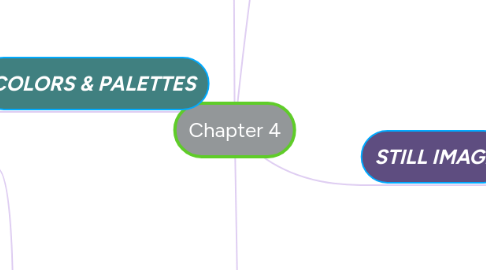
1. 3-D DRAWING & RENDERING
1.1. 3-D animation tools
1.1.1. Daz3D
1.1.2. Form*Z
1.1.3. NewTek's Lightwave
1.1.4. Autodesk's Maya
1.1.5. Trimble's SketchUp
1.2. Features of a 3-D application
1.2.1. Modeling
1.2.1.1. Placing all the elements into 3-D space
1.2.2. Extrusion
1.2.2.1. The shape of a plane surface extends some distance
1.2.3. Lathing
1.2.3.1. A profile of the shape is rotated around a defined axis
1.3. Rendering
1.3.1. Use of intricate algorithms to apply user-specified effects
1.3.2. take many hours for a single image
2. COLORS & PALETTES
2.1. Additive Color
2.1.1. a color is created by combining colored light sources
2.1.1.1. 3 primary colors- red, green, blue (RGB)
2.2. Subtractive color
2.2.1. color is created by combining colored media such as paints or ink
2.2.2. is the process used to create color in printing
2.3. Dithering
2.3.1. digitised images are 24 bit, 16 million color depth
2.3.2. is a process whereby the color value of each pixel is changed to the closest matching color value in the target palette
3. IMAGE FILE TYPE
3.1. Macintosh formats
3.1.1. the most commonly used format is PICT
3.1.2. PICT is a versatile format developed by Apple
3.2. Windows formats
3.2.1. The most commonly used image file format on Windows is DIB, also known as BMP
3.2.2. DIB stands for device-independent bitmaps
3.3. Cross-platform formats
3.3.1. JPEG
3.3.1.1. commonly used standard method of compression for photographic images
3.3.1.2. no transparency
3.3.1.3. no animation
3.3.1.4. lossy compression technique
3.3.2. GIF
3.3.2.1. uses lossless compression technique
3.3.2.2. image can have transparent portion
3.3.2.3. animation possible
3.3.3. PNG
3.3.3.1. support more than 16.7 million colors
3.3.3.2. use lossless compression technique
3.3.3.3. image can have transparent portion
3.3.3.4. no animation
4. STILL IMAGE
4.1. Bitmap (raster)
4.1.1. derived from the words "bit"
4.1.2. means simplest element in digital world
4.1.3. simple matrix of the tiny dots that form an image
4.1.4. bitmapped images can have varying bit and color depths
4.1.5. made up of individual dots
4.1.6. advantages
4.1.6.1. have different textures on the drawings, detailed and comprehensive
4.1.7. disadvantage
4.1.7.1. large file size
4.1.7.2. not easy to make modification to objects / drawings
4.1.7.3. graphics become "blocky" when the size is increased
4.1.8. bitmap sources
4.1.8.1. capture using a camera
4.1.8.2. capture from a photo or other artwork using a scanner to digitize the image
4.1.8.3. making a bitmap from scratch with a paint or drawing program
4.1.9. bitmap software
4.1.9.1. Adobe's Photoshop and Illustrator
4.1.9.2. Corel's Painter and CorelDraw
4.2. Vector-drawn graphic
4.2.1. Applications of vector-drawn object
4.2.2. How vector-drawn images work
4.2.2.1. CAD programs needed by architects and engineers
4.2.2.2. Graphic artists designing for the print media
4.2.2.3. 3-D animation programs - changes of position, rotation, and shading of light
4.2.3. Vector-drawn images versus bitmaps
4.2.3.1. a line that described by the location of its two endpoints
4.2.3.2. Vector drawing makes use of Cartesian coordinates
4.2.4. Advantages
4.2.4.1. Vector images use less memory space
4.2.4.2. Vector objects are easily scalable without loss of resolution or image quality
4.2.4.3. Easy to edit the drawing as each object is independent of the other
4.2.5. Disadvantages
4.2.5.1. Objects / drawings cannot have texture
4.2.5.2. cannot be used for photorealistic images

